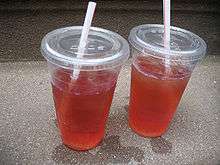White Zinfandel

White Zinfandel, often abbreviated as White Zin, is a dry to sweet, pink-colored rosé. White Zinfandel is made from the Zinfandel wine grape, which would otherwise produce a bold and spicy red wine. White Zinfandel is not a grape variety but a method of processing Zinfandel grapes. As of February 2006, White Zinfandel accounted for 10% of all wine sold by volume, making it the third most popular varietal in the United States,[1] outselling Red Zinfandel 6:1 by volume.[1]
History of White Zinfandel
Zinfandel was first made into a rosé wine in 1869 by the El Pinal Winery in Lodi, California. The resulting wine was thought of highly enough that California viticultural commissioner Charles Wetmore, the later founder of Cresta Blanca Winery, advocated Zinfandel's use as a white wine grape.
In the 1970s Sutter Home Winery was a producer of premium Zinfandel red wine in the Napa Valley. To increase concentration in their wines, they used the saignée technique to bleed off some of the grape juice before fermentation, to increase the impact of compounds in the skins on the remaining wine. The excess juice was separately fermented into a dry, almost white wine that Sutter Home called "White Zinfandel."
In 1975, Sutter Home's White Zinfandel experienced a "stuck fermentation", a problem that occurs when the yeast dies out before consuming all of the sugar.[2] This problem juice was set aside. Some weeks later the winemaker, Steve Bertolucci, tasted it, and preferred this accidental result, which was a sweet pink wine. This is the style that became popular and today is known as White Zinfandel, but in the early days was known as Cabernet Blanc.[3] Sutter Home realized they could sell far more White Zinfandel than anything they had produced to date, and gradually became a successful producer of inexpensive wines. They remain one of the biggest producers of the wine, with annual shipments of over 4 million cases.
The demand for White Zinfandel resulted in extended commercial viability of old vine Zinfandel vineyards, which saved them from being ripped out.[4] When the fine wine boom started in the 1980s, demand for red Zinfandel picked up considerably and these vineyards became prized for the low yields from century-old vines. With White Zinfandel outselling red Zinfandel 6:1 by volume, there's not enough juice left over from red wine production to satisfy demand for White Zinfandel. So Sutter Home (and most producers today) grow grapes specifically for use in White Zinfandel, in places like the Central Valley of California. Production costs are substantially lower and fruit quality is not as important to the final taste as it would be in a dry table wine.
See also
- California wine
- White Merlot
- Oeil de perdrix, the style of wine that Sutter was making that led to White Zinfandel
References
- 1 2 Wine Business Insider, March 27, 2006
- ↑ Zinposium 2002: A Major Event. Vineyard & Winery Management Sep/Oct 2002
- ↑ Lechmere A (2002) First white 'Cabernet Sauvignon' released Decanter May 14, 2002
- ↑ San Francisco Gate (2005-07-28).
